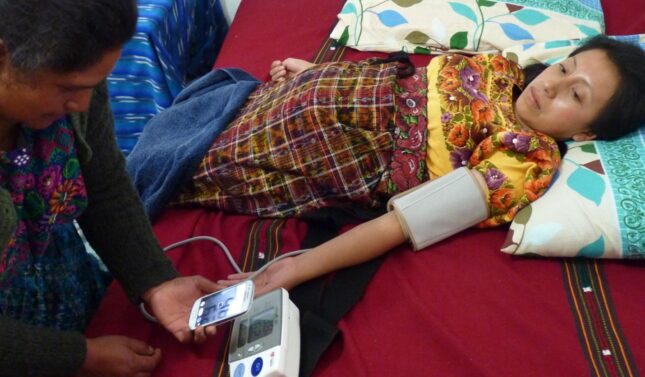-
AI in Community Care: Can Co-design Shift the Balance in Maternal Mortality?

We face a global crisis of maternal mortality that extends to untenable disparities within the United States. Yet too often, the populations most affected by such health disparities are sidelined in the creation of solutions to address them.
Using a co-design approach offers a way to reduce power asymmetries and promote equity in global health. Co-design builds on a combination of participatory action research and agile design methods to center end-users in the development of innovations. The starting point of the co-design process is to identify community-led priorities.
While co-design can be used in any global health intervention, low-cost technologies offer distinct opportunities for the approach. The availability of affordable, high-quality mobile technology— and their specific applications for the delivery of global health—has exploded, leapfrogging generations of legacy hardware and infrastructure. Advances in tools including sensor miniaturization, microchip technology, and artificial intelligence mean that high-quality surveillance, diagnostics, and treatment delivery are possible beyond the limited reach of traditional health care facilities and provider networks. Since 86% of humans live where there is mobile network coverage—the possibilities are dizzying!
Realizing the Potential
Yet for all their potential, low-cost technologies in global health walk the knife edge of equity. Technologies intended to democratize and improve access to health care can perpetuate the entrenched elitism of research institutions, industry, and regulatory systems. This means that who gets to “innovate” in global health continues to be dominated by high-income countries.
Co-design pushes back against these power dynamics and the received wisdom of economies of scale in global health, which assumes that programs can be developed centrally and delivered with minimal adaptation. By centering the ideas and strategies of the end-user communities and positioning them as owners of the innovations, co-design improves sustainability via the investment it creates in project outcomes.

One example of how this works out in practice is safe+natal—a perinatal monitoring toolkit and program to improve the continuum of maternal health care. The toolkit was co-designed by Maya midwives in rural Guatemala, where most women give birth at home with a lay midwife. Because racism and structural violence make it difficult for Maya women to access facility-based maternal care, there is a critical need to support safe home birth and to reduce barriers for facility-based care.
The safe+natal toolkit includes a smartphone app, a low-cost blood pressure device whose data is captured by the phone’s camera, and a low-cost Doppler device that can accurately detect changes in fetal heart rate and fetal growth restriction, which are critical signals in detecting perinatal complications. The midwives co-designed the pictogram-driven user-interface with audio instructions to support use by Kaqchikel Maya speakers of all literacy levels.
The safe+natal app also includes pictogram checklists for adverse antenatal signals, symptoms, and events per WHO standards. If any indicators are checked, or if the maternal blood pressure is out of range, or if the fetal heart rate exhibits abnormal indications, the app refers the patient for facility-based care using a triple-redundant messaging system (SMS, voice, GPRS/Wi-Fi data connectivity) to reduce the chances of a missed or delayed referral.
From Algorithms to Access
Over the last decade, community midwives have collected thousands of fetal Doppler recordings. NIH-funded research has allowed the team to develop AI algorithms to detect both hypertensive disorders of pregnancy and intrauterine growth restriction. Funding from Google.org will enable the algorithms to run in the app itself, so that even in places with no cellphone connectivity, informed decisions can be made about the health of mothers and babies. These algorithms also are tuned to the local population—and can be set to continually learn from them by accepting input from the midwives and integrating local knowledge.
The local implementation organization—Wuqu’ Kawoq│Maya Health Alliance—has built on existing partnerships with the government health service to develop a care navigation program. This allows support for referrals to further care when the safe+natal toolkit identifies a perinatal risk.
Thus far, use of the toolkit has been shown to increase appropriate referrals, reduce hypertension, and reduce mortality in Guatemala. It has become the standard of care for midwife-led maternal care in the region. And the population reached by midwives using safe+natal in Guatemala has seen a marked improvement from having one of the highest maternal mortality rates in the Western hemisphere to near-zero rates.
One of the key lessons of safe+natal is that co-design works. And the toolkit team is now preparing for expansion to sites in the United States, Sierra Leone, Tanzania, Ethiopia, and beyond. But co-design has to be more than a buzzword, or it will be just another shiny new thing to be left behind in villages worldwide.
Rachel Hall-Clifford, PhD, MPH, MSc is a medical anthropologist and global health practitioner at Emory University focused on co-design approaches.
Gari Clifford, DPhil, FIEEE, is the Chair of Emory’s Department of Biomedical Informatics and a Professor of Biomedical Engineering and Biomedical Informatics at Emory University and Georgia Institute of Technology
Sources: Acta Obstetricia et Gynecologica Scandinavica; Frontiers in Artificial Intelligence; Frontiers in Physiology; Journal of Health Informatics in Developing Countries; Wuqu’ Kawoq / Maya Health Alliance Physiological Measurement; Reproductive Health.
Photo credit: Cover: A midwife uses the safe+natal toolkit; In-Text: A team of Maya midwives co-design an early version of safe+natal. Used with permission courtesy of safe+natal.
 A Publication of the Stimson Center.
A Publication of the Stimson Center.




